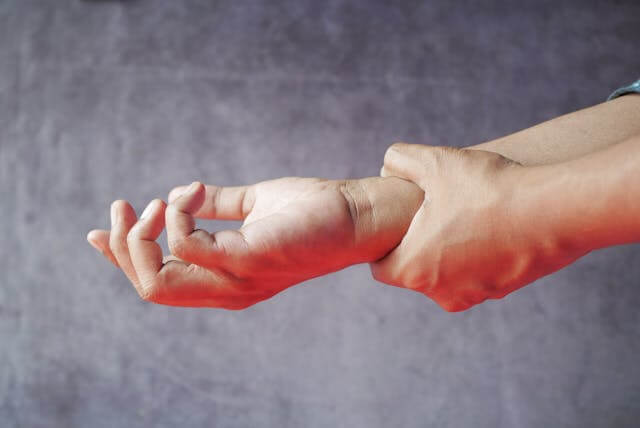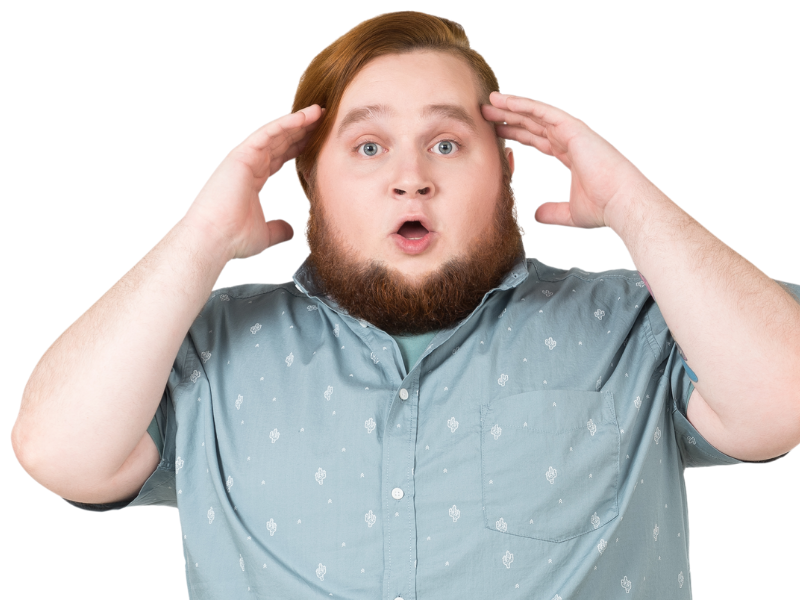It’s hard to imagine a light touch or gentle breeze causing pain. But this is the reality for people with allodynia – a symptom of migraine that’s often overlooked. Allodynia can make simple actions like washing your face or wearing glasses hurt. This can further limit migraineurs’ daily activities and quality of life. Keep reading to learn what allodynia is and how it’s connected to migraine.
What is Allodynia?
Allodynia (pronounced ‘a-luh-di-nee-uh’) is a type of nerve pain caused by things that aren’t normally painful. For people with allodynia, light touches and simple activities like hair brushing can trigger extreme pain.
Allodynia is rare among the general population. But it’s common among those with neuropathic pain. Between 15 to 50% of people with neuropathic pain suffer from allodynia.1 The exact cause of allodynia is unclear. However, it’s linked to several conditions, including fibromyalgia, diabetic neuropathy, trigeminal neuralgia, and yes – migraine.1
Allodynia Symptoms
The hallmark sign of allodynia is pain from stimuli that don’t typically cause pain. However, there are three types of allodynia – and symptoms vary depending on the form.
Types of allodynia include:
- Tactile (static) allodynia: Pain that arises when an object lightly touches or presses against the skin. This could be due to clothing (like elastic waistbands), a light tap on the shoulder, or wind blowing hair against your face.
- Mechanical (dynamic) allodynia: Pain triggered by an object moving across the skin. This could be from combing your hair, shaving your face, or bedsheets brushing against your skin.
- Thermal allodynia: Pain that occurs from mild temperature changes. With this form, a warm plate or even a small drop of cold water may trigger intense pain.
Some people have only one form of allodynia. Others may have all three. Some may experience allodynia in one location. Others may feel it all over, like having a full-body sunburn.
Allodynia vs Hyperalgesia: What’s the Difference?
Allodynia is often mistaken for hyperalgesia, another form of nerve pain. But they’re not the same thing.
Allodynia is pain that occurs from stimuli that don’t usually provoke pain. Hyperalgesia, on the other hand, is an increased sensitivity to pain. The main difference is hyperalgesia comes from stimuli that normally trigger pain.2 However, with hyperalgesia, the level of pain is more intense than expected.
To make matters more confusing, some people may suffer from both allodynia and hyperalgesia.

What Causes Allodynia?
The exact cause of allodynia isn’t fully understood. However, scientists think central sensitization plays a role.3
Central sensitization is when the nervous system becomes overly active. This causes the nervous system to react to non-painful stimuli like light touches with high levels of pain. For example, a soft peck on the cheek would only be a sensation for most people. But for those with allodynia, that same peck could trigger intense pain.
Many factors can increase the risk of allodynia, including:
- Migraine: About 65% of people with migraine experience allodynia during attacks.1 This neurological disorder causes debilitating headaches, as well as other symptoms like nausea.
- Fibromyalgia: A chronic condition that causes pain and tenderness throughout the body, as well as fatigue, depression, and sleep issues.4
- Diabetic neuropathic pain: Roughly 1 in 10 Americans have diabetes.1 Of those, at least 10% develop neuropathic pain, a type of nerve damage that results from diabetes.
- Trigeminal neuralgia: This rare neurological condition causes severe facial pain, similar to electric shocks. It’s caused by irritation of the trigeminal nerve.5
- Medications: Certain medications, like opioids, can make you more sensitive to pain.6 This is known as opioid-induced hyperalgesia. Chemotherapy drugs can also increase the risk of nerve pain.7
- Shingles: Allodynia is a common symptom of shingles, a painful rash caused by the same virus that causes chicken pox. For some people, allodynia lingers for weeks or months after the shingles rash clears.8
- Nutrition deficiencies: Not getting enough B vitamins or vitamin D can cause nerve damage and increase the risk of allodynia.1
- Alcohol overconsumption: Drinking too much alcohol can also damage nerves, which may lead to allodynia.9

Drinking too much alcohol can by linked to allodynia
Allodynia and Migraine: What’s the Link?
Allodynia is not just a random association with migraine but may be an unavoidable consequence for many patients.10 Allodynia is a common migraine symptom. Yet not all migraineurs experience allodynia. It’s most prevalent among women and those with migraine with aura.11, 12
Allodynia usually occurs during the headache phase of migraine attacks. However, some migraine sufferers get allodynia between attacks, in the interictal phase too.13
During a migraine attack, the nervous system becomes hypersensitive.14 This can cause it to overreact to sensory input and alter pain processing. As the frequency and severity of migraine attacks increase, so does the risk of allodynia. Having allodynia also increases the risk of episodic migraine progressing into chronic migraine. This makes migraine prevention extra important for those with allodynia.
Allodynia Treatment & Prevention
Treatment depends on the underlying condition causing allodynia. For those with diabetic neuropathic pain, this could mean making dietary changes to steady the blood sugar. If nutritional deficiencies are to blame, supplementation may be needed. Topical treatments like lidocaine ointment or capsaicin patches may also offer relief.
As for migraine, triptans are often prescribed to treat acute attacks. However, these meds are often not as effective once allodynia pops up.14 And relying on triptans too much can lead to medication overuse headaches.15
Luckily, many lifestyle habits and natural remedies may help keep allodynia at bay:
- Cognitive behavioral therapy (CBT). This form of therapy helps people understand how their thoughts and emotions affect their perception of pain. Research suggests it may benefit those with chronic pain.16
- Physical therapy. Physical therapists may use desensitization techniques to help those with allodynia.1 This involves applying gentle pressure to the skin for short periods. Over time, this may help reset the pain threshold.
- Mindfulness training. Mindfulness-based practices like meditation reduce stress, which can impact the perception of pain. Research shows mindfulness can ease pain and help people cope with pain better.16

A man practicing mindfulness
- Acupuncture. Some research suggests acupuncture may relieve pain due to central sensitization.17
- Lifestyle changes. Simple tweaks like wearing loose clothes or switching your hairbrush may ease symptoms of allodynia.
- Eat a healthy diet. A nutritious diet, rich in colorful fruits and veggies helps prevent the vitamin deficiencies linked with allodynia. Daily sun exposure can also help you meet your vitamin D needs.
- Avoid triggers. Steering clear of migraine triggers can help prevent attacks from occurring in the first place. Fewer attacks mean less risk of allodynia. To learn more about common migraine triggers, check out this article.
- Nutritional support. Just as allodynia is linked with nutrition deficiencies, the same goes for migraine. About half of migraine sufferers are low in magnesium, a mineral crucial for nerve function.18 Correcting this deficiency can be very beneficial for migraine sufferers. Research also suggests riboflavin (vitamin B-2) can support brain cellular energy.19 MigreLief delivers 360 mg of magnesium, 400 mg of riboflavin, and 100 mg of Puracol feverfew in each dose, for targeted triple-action migraine support.
Takeaways
Allodynia is a type of nerve pain triggered by stimuli that don’t typically cause pain. This could be due to mild temperature changes, a pat on the back, or even wearing clothes. Allodynia is linked to several health conditions, including migraine. Certain medications and nutritional deficiencies can also lead to allodynia. Treatment involves addressing the underlying condition that’s at the root of allodynia.
For those with migraine, prevention strategies can help reduce the occurrence of allodynia. Avoiding triggers, keeping a healthy lifestyle, and getting nutritional support can help keep migraine symptoms like allodynia in check.
Sources:
- https://www.ncbi.nlm.nih.gov/books/NBK537129/
- https://pubmed.ncbi.nlm.nih.gov/25142459/
- https://www.sciencedirect.com/topics/medicine-and-dentistry/allodynia
- https://www.ncbi.nlm.nih.gov/pmc/articles/PMC6016048/
- https://www.ninds.nih.gov/health-information/disorders/trigeminal-neuralgia
- https://pubmed.ncbi.nlm.nih.gov/21412369/
- https://www.ncbi.nlm.nih.gov/pmc/articles/PMC6471666/
- https://pubmed.ncbi.nlm.nih.gov/10946169/
- https://www.ncbi.nlm.nih.gov/pmc/articles/PMC3370340/
- https://pubmed.ncbi.nlm.nih.gov/19271948/
- https://pubmed.ncbi.nlm.nih.gov/24080152/
- https://www.ncbi.nlm.nih.gov/pmc/articles/PMC5494713/
- https://americanmigrainefoundation.org/resource-library/what-to-know-about-allodynia/
- https://americanmigrainefoundation.org/resource-library/what-is-allodynia/
- https://www.ncbi.nlm.nih.gov/pmc/articles/PMC5690477/
- https://www.sciencedirect.com/science/article/pii/S169726002030065X?via%3Dihub
- https://onlinelibrary.wiley.com/doi/10.1155/2019/6173412
- https://pubmed.ncbi.nlm.nih.gov/9523054/
- https://pubmed.ncbi.nlm.nih.gov/26780280/


